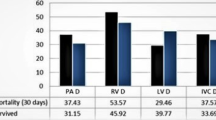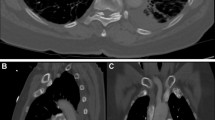Abstract
Purpose
The purpose of this study was to evaluate results from computed tomography pulmonary angiography (CTPA) indicative of right ventricular dysfunction (RVD), and to assess the relationship of these results with cardiac biomarkers and mortality among patients with acute PE.
Materials and methods
This retrospective study involved 118 patients with acute PE proved by CTPA. CTPA variables were analyzed and compared with cardiac biomarkers and echocardiography (ECHO) findings.
Results
Compared with ECHO, the sensitivity, specificity, positive predictive value, and negative predictive value of CTPA for detection of RVD were 85.7, 91.7, 93.7, and 81.5 %, respectively. ROC curve analysis for prediction of RVD resulted in areas under the curve of 0.925 for RV dimension (95 % CI 0.879−0.971, p < 0.001) and 0.913 for main pulmonary artery (MPA) diameter (95 % CI 0.863−0.963, p < 0.001). The optimum cut-off values for prediction of RVD were 37.5 mm for RV dimension and 29.1 mm for MPA diameter. These values were also statistically significantly greater for non-survivors than for survivors (p = 0.001, p < 0.001, respectively) and significantly associated with cardiac biomarkers.
Conclusion
It was found that CTPA findings were significantly associated with the presence of RVD in ECHO, cardiac biomarkers, and mortality of patients with acute PE.



Similar content being viewed by others
References
Burns SK, Haramati LB. Diagnostic imaging and risk stratification of patients with acute pulmonary embolism. Cardiol Rev. 2012;20:15–24.
Goldhaber SZ. Venous thromboembolism: epidemiology and magnitude of the problem. Best Pract Res Clin Haematol. 2012;25:235–42.
Remy-Jardin M, Pistolesi M, Goodman LR, et al. Management of suspected acute pulmonary embolism in the era of CT angiography: a statement from the Fleischner Society. Radiology. 2007;245:315–29.
Henzler T, Barraza JM Jr, Nance JW Jr, et al. CT imaging of acute pulmonary embolism. J Cardiovasc Comput Tomogr. 2011;5:3–11.
Sanchez O, Trinquart L, Colombet I, et al. Prognostic value of right ventricular dysfunction in patients with haemodynamically stable pulmonary embolism: a systematic review. Eur Heart J. 2008;29:1569–77.
Kang DK, Thilo C, Schoepf UJ, Barraza JM Jr, Nance JW Jr, Bastarrika G, et al. CT sings of right ventricular dysfunction; prognostic role in acute pulmonary embolism. JACC Cardiovasc Imaging. 2011;4:841–9.
Trujillo-Santos J, den Exter PL, Gómez V, Del Castillo H, Moreno C, van der Hulle T, Huisman MV, et al. Computed tomography-assessed right ventricular dysfunction and risk stratification of patients with acute non-massive pulmonary embolism: systematic review and meta-analysis. J Thromb Haemost. 2013;11:1823–32.
Lega JC, Lacasse Y, Lakhal L, Provencher S. Natriuretic peptides and troponins in pulmonary embolism: a meta-analysis. Thorax. 2009;64:869–75.
Golpe R, Pe´rez-de-Llano LA, Castro-Anon O, et al. Right ventricle dysfunction and pulmonary hypertension in hemodynamically stable pulmonary embolism. Respir Med. 2010;104:1370–6.
Wittram C, Maher MM, Yoo AJ, Kalra MK, Shepard JO, McLoud TC. CT angiography of pulmonary embolism: diagnostic criteria and causes of misdiagnosis. Radiographics. 2004;24:1219–39.
Grifoni S, Olivotto I, Cecchini P, Pieralli F, Camaiti A, Santoro G, et al. Short-term clinical outcome of patients with acute pulmonary embolism, normal blood pressure, and echocardiographic right ventricular dysfunction. Circulation. 2000;101:2817–22.
Ribeiro A, Lindmarker P, Juhlin-Dannfelt A, et al. Echocardiography doppler in pulmonary embolism: right ventricular dysfunction as a predictor of mortality. Am Heart J. 1997;134:479–87.
Lim KE, Chan CY, Chu PH, et al. Right ventricular dysfunction secondary to acute massive pulmonary embolism detected by helical computed tomography pulmonary angiography. Clin Imaging. 2005;29:16–21.
Jimenez D, Aujesky D, Yusen RD. Risk stratification of normotensive patients with acute symptomatic pulmonary embolism. Br J Haematol. 2010;151:415–24.
Sakuma M, Konno Y, Shirato K. Increasing mortality from pulmonary embolism in Japan, 1951–2000. Circ J. 2002;66:1144–9.
Goldhaber SZ. Advanced treatment strategies for acute pulmonary embolism, including thrombolysis and embolectomy. J Thromb Haemost. 2009;7:322–7.
Kreit JW. The impact of right ventricular dysfunction on the prognosis and therapy of normotensive patients with pulmonary embolism. Chest. 2004;125:1539–45.
Goldhaber SZ. Echocardiography in the management of pulmonary embolism. Ann Intern Med. 2002;136:691–700.
Contractor S, Maldjian PD, Sharma VK, Gor DV. Role of Helical CT in detecting right ventricular dysfunction secondary to acute pulmonary embolism. J Comput Assist Tomogr. 2006;4:587–91.
Ozsu S, Karaman K, Mentese A, et al. Combined risk stratification with computerized tomography/echocardiography and biomarkers in patients with normotensive pulmonary embolism. Thromb Res. 2010;126:486–92.
Apfaltrer P, Henzler T, Meyer M, et al. Correlation of CT angiographic pulmonary artery obstruction scores with right ventricular dysfunction and clinical outcome in patients with acute pulmonary embolism. Eur J Radiol. 2012;81:2867–71.
Park JR, Chang SA, Jang SY, et al. Evaluation of right ventricular dysfunction and prediction of clinical outcomes in acute pulmonary embolism by chest computed tomography: comparisons with echocardiography. Int J Cardiovasc Imaging. 2012;28:979–87.
Henzler T, Roeger S, Meyer M, et al. Pulmonary embolism: CT signs and cardiac biomarkers for predicting right ventricular dysfunction. Eur Respir J. 2012;39:919–26.
Cok G, Tasbakan MS, Ceylan N, Bayraktaroglu S, Duman S. Can we use CT pulmonary angiography as an alternative to echocardiography in determining right ventricular dysfunction and its severity in patients with acute pulmonary thromboembolism? Jpn J Radiol. 2013;31:172–8.
Aribas A, Keskin S, Akilli H, Kayrak M, Erdogan HI, Guler I, et al. The use of axial diameters and CT obstruction scores for determining echocardiographic right ventricular dysfunction in patients with acute pulmonary embolism. Jpn J Radiol. 2014;32:451–60.
Vuilleumier N, Verschuren F, Perrier A, Bounameaux H, Turck N, Sanchez JC, et al. Cardiac biomarkers for risk stratification in nonmassive pulmonary embolism: a multicenter prospective study. J Thromb Haemost. 2009;7:391–8.
Seon HJ, Kim KH, Lee WS, Choi S, Yoon HJ, Ahn Y, et al. Usefulness of computed tomographic pulmonary angiography in the risk stratification of acute pulmonary thromboembolism. Circ J. 2011;75:428–36.
Conflict of interest
The authors declared no potential conflict of interests with regard to the research, authorship, and/or publication of this paper.
Author information
Authors and Affiliations
Corresponding author
About this article
Cite this article
İn, E., Aydın, A.M., Özdemir, C. et al. The efficacy of CT for detection of right ventricular dysfunction in acute pulmonary embolism, and comparison with cardiac biomarkers. Jpn J Radiol 33, 471–478 (2015). https://doi.org/10.1007/s11604-015-0447-9
Received:
Accepted:
Published:
Issue Date:
DOI: https://doi.org/10.1007/s11604-015-0447-9




